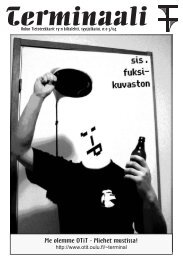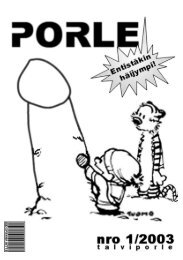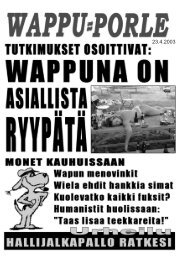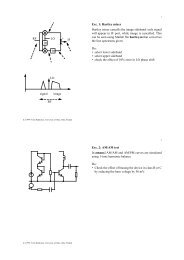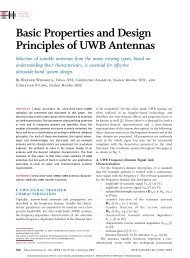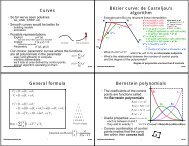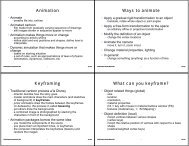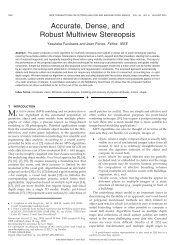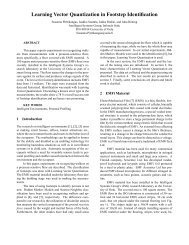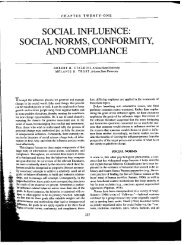On the Effect of Radio Channel Propagation Models - Oulu
On the Effect of Radio Channel Propagation Models - Oulu
On the Effect of Radio Channel Propagation Models - Oulu
Create successful ePaper yourself
Turn your PDF publications into a flip-book with our unique Google optimized e-Paper software.
ON THE EFFECT OF RADIO CHANNEL PROPAGATION MODELS<br />
TO THE AD HOC NETWORK PERFORMANCE<br />
Jarmo Prokkola<br />
VTT Technical Research Centre <strong>of</strong> Finland,<br />
<strong>Oulu</strong>, Finland<br />
ABSTRACT<br />
In this paper we study <strong>the</strong> behavior <strong>of</strong>ad hoc network performance<br />
under different propagation models. Ad hoc networks<br />
are <strong>of</strong>ten studied with unrealistic cut propagation<br />
models, where <strong>the</strong> propagating signal is completely cut to<br />
some predefined distance. The worst drawback in this kind<br />
modeling is that it fails to include <strong>the</strong> effect <strong>of</strong> multiple access<br />
interference (MAI). Since cut propagation model is<br />
taken as a point <strong>of</strong> comparison, free space propagation<br />
model will provide <strong>the</strong> simplest enhancement to enable<br />
realistic MAI calculation. In addition, we also use a forest<br />
propagation loss model, which provides a more realistic<br />
environment for military scenarios. We study <strong>the</strong> performance<br />
in two cases. nodes equipped with our BCCA (Bi-<br />
Code <strong>Channel</strong> Access) and BC-MAC (Bi-Code MAC), and<br />
nodes with IEEE 802.11.<br />
The study shows that <strong>the</strong>re are significant differences in<br />
<strong>the</strong> absolute performance between scenarios with different<br />
propagation models. This clearly shows <strong>the</strong> importance <strong>of</strong><br />
lower layer modeling, although <strong>the</strong> focus would be on <strong>the</strong><br />
upper layer performance (e.g., on <strong>the</strong> application layer<br />
Quality <strong>of</strong> Service (QoS)). The study also shows that BC-<br />
MAC outperforms IEEE 802.11 regardless <strong>of</strong> <strong>the</strong> propagation<br />
modeling. Despite <strong>the</strong> fact that <strong>the</strong> ranking <strong>of</strong> <strong>the</strong> performance<br />
between BC-MAC and 802.11 was unchanged in<br />
this study, <strong>the</strong> great differences in <strong>the</strong> absolute performance<br />
questions <strong>the</strong> generality <strong>of</strong> <strong>the</strong> results obtained with<br />
simplified lower layer models. This should be taken into<br />
consideration especially in military related studies, where<br />
<strong>the</strong> focus <strong>of</strong>ten is in <strong>the</strong> absolute performance <strong>of</strong> a certain<br />
scenario and not only in <strong>the</strong> relative difference between<br />
some methods.<br />
INTRODUCTION<br />
In this study, we focus on <strong>the</strong> effect <strong>of</strong> radio signal propagation<br />
modeling to <strong>the</strong> performance <strong>of</strong> ad hoc networks.<br />
<strong>Propagation</strong> modeling has been studied a lot, but modeling<br />
in network level simulations, and especially in <strong>the</strong> case <strong>of</strong><br />
ad hoc networks, has been imperfect. Many <strong>of</strong> <strong>the</strong> studies<br />
so far use unrealistic cut radio channel model, which fails<br />
to model multiple access interference. Yet, some studies<br />
1 <strong>of</strong> 7<br />
Timo Braysy and Teemu Vanninen<br />
Centre for Wireless Communications (CWC),<br />
University <strong>of</strong> <strong>Oulu</strong>, <strong>Oulu</strong>, Finland<br />
for considering <strong>the</strong> importance <strong>of</strong> realistic physical layer<br />
in design <strong>of</strong> ad hoc network routing protocols has been<br />
addressed (e.g., [1]). In [2], for example, a shadowing<br />
model is used in ad hoc network simulations. The fluctuations<br />
in signals strength causes route breakages,<br />
which in turn lead to decreased packet delivery ratio,<br />
increased control traffic and increased packet delay that<br />
cause user perceived QoS to be decreased.<br />
<strong>On</strong>ly few papers address <strong>the</strong> effect <strong>of</strong> physical layer parameters<br />
to <strong>the</strong> performance <strong>of</strong> routing and MAC layer<br />
functions in wireless ad hoc networks. In [3], a simulation<br />
modeling study has been performed to demonstrate<br />
<strong>the</strong> possibly significant effect <strong>of</strong> <strong>the</strong> different physical<br />
layer properties such as physical layer preamble length,<br />
interference, fading and path loss. The study also addresses<br />
<strong>the</strong> importance <strong>of</strong> MAI calculation and discusses<br />
about <strong>the</strong> ways how different simulation tools model <strong>the</strong><br />
radio channel properties. In [4] and [5] a sophisticated<br />
indoor wireless channel model based on ray-tracing and<br />
Markov chains is presented and developed for NS-2<br />
simulation tool.<br />
The novelty in our paper is <strong>the</strong> extensive simulation<br />
study <strong>of</strong> propagation modeling impacts to <strong>the</strong> higher<br />
layer performance. We have set <strong>the</strong> parameters (e.g.,<br />
transmission power) in a way that <strong>the</strong> results <strong>of</strong> different<br />
scenarios are easily comparable to each o<strong>the</strong>r. The models<br />
used here are: free space propagation loss (FSL), forest<br />
propagation loss (FPL), and two cut propagation (CP)<br />
models, CP-LP (low power) and CP-HP (high power).<br />
CP-HP is a good point <strong>of</strong> comparison, since it is quite<br />
similar to <strong>the</strong> simplified radio channel models used in<br />
several studies. We use mainly our BCCA method and<br />
BC-MAC, but also IEEE 802.11 is used as a reference,<br />
since one <strong>of</strong> <strong>the</strong> goals is to compare BC-MAC and<br />
802.1 1 under different propagation models.<br />
SYSTEM DESCRIPTION<br />
A. BCCA and BC-MAC<br />
Bi-Code <strong>Channel</strong> Access (BCCA) is a dual channel access<br />
method designed especially for <strong>the</strong> needs <strong>of</strong> ad hoc<br />
networking. The basic idea is that <strong>the</strong> ad hoc nodes are
able to track two separate channels simultaneously. In our<br />
spread spectrum approach, nodes are able to track transmissions<br />
with two different spreading codes. <strong>On</strong>e is a<br />
common code channel (C-code), which is used for route<br />
maintenance and broadcast communications. The o<strong>the</strong>r is a<br />
receiver based code channel (R-code), which is unique for<br />
each node, unlike <strong>the</strong> C-code. R-code is used for all directed<br />
transmission (e.g., data) per hop basis. [6]<br />
Since BCCA is a channel access method to enable distributed<br />
CDMA-like (Code Division Multiple Access) communications<br />
for ad hoc networks, a medium access control<br />
(MAC) method is also needed. BC-MAC is designed to be<br />
used with BCCA. It is a straightforward CSMA-based<br />
(Carrier Sense Multiple Access) MAC solution with fast<br />
ARQ (Automatic Repeat Request) implementation. BC-<br />
MAC with BCCA has been shown to have very high performance<br />
in ad hoc environment. [7]<br />
With <strong>the</strong> use <strong>of</strong> BCCA, it is required that <strong>the</strong> R-type<br />
spreading codes <strong>of</strong> <strong>the</strong> nodes are known, For <strong>the</strong> cases<br />
where <strong>the</strong> codes are unknown, an efficient network layer<br />
spreading code distribution method is being developed.<br />
However, we will use <strong>the</strong> assumption <strong>of</strong> known codes in<br />
this paper, since it is a fair assumption in military scenarios.<br />
Hereafter, when we refer to BC-MAC, it is assumed<br />
that BCCA functionality is also implemented to it.<br />
B. IEEE 802.11<br />
The basic IEEE 802.11 (later referred to as 802.11) is considered<br />
as a point <strong>of</strong> comparison. The modeling <strong>of</strong> 802.11<br />
is based on <strong>the</strong> basic OPNET model <strong>of</strong> 802.11 with some<br />
modifications to enable <strong>the</strong> functionality with <strong>the</strong> used<br />
routing protocol (as in our previous studies [6], [7]). Some<br />
modifications were also needed to enable <strong>the</strong> possibility to<br />
use different propagation models, but no functional<br />
changes to <strong>the</strong> MAC have been made.<br />
The DSSS (Direct Sequence Spread Spectrum) mode <strong>of</strong><br />
802.11 is used, since DS spreading is also used in BC-<br />
MAC. Virtual carrier sensing is not used, because it produces<br />
additional overhead [8], which is not desired (multiple<br />
handshaking transmissions, latency, capacity decrement<br />
under heavy traffic). Carrier sensing is done by<br />
power level measurement with a threshold in both 802.11<br />
and BC-MAC. This threshold is set according to <strong>the</strong> power<br />
level, where <strong>the</strong> reception is just more likely to succeed<br />
than fail in <strong>the</strong>ory.<br />
C. The Physical Layer<br />
At <strong>the</strong> physical layer, channel data rate is set to 1 Mbit/s.<br />
To allow potentiality for interference suppression and to<br />
enhance LPD (Low Probability <strong>of</strong> Detection) and LPI<br />
(Low Probability <strong>of</strong> Interception) properties, sufficient<br />
2 <strong>of</strong> 7<br />
spreading factor is needed. Spreading code length <strong>of</strong> Nc<br />
= 63 chip is used. With bit-wise spreading, processing<br />
gain is directly 63 (- 18.0 dB). To make fair comparisons<br />
between BC-MAC and 802.11, <strong>the</strong> same spreading<br />
factor is also set to 802.11 instead <strong>of</strong> <strong>the</strong> standard value<br />
<strong>of</strong> 11. The frame formats are set to be equal according to<br />
- 802.11. The systems operate on 2.4 GHz ISM (Industrial,<br />
Scientific and Medical) frequency band.<br />
B. The Network Layer<br />
The network layer functionality is kept simple enough so<br />
that it does not provide any extra effects to <strong>the</strong> results.<br />
The functionality is mainly under control <strong>of</strong> Ad hoc <strong>On</strong>demand<br />
Distance Vector (AODV) routing protocol with<br />
some basic characteristics <strong>of</strong> IP (Internet Protocol). But<br />
for example address resolution protocol (ARP) is not<br />
used, instead, it is assumed for simplicity, that <strong>the</strong> MAC<br />
and network layer share <strong>the</strong> same address base.<br />
AODV is a reactive pure on-demand type routing protocol,<br />
where routes are formed and updated only when<br />
needed [9]. The used OPNET model <strong>of</strong> AODV is <strong>the</strong><br />
same as in our previous work (e.g., [6], where it is also<br />
described how to enable BCCA functionality with<br />
AODV). AODV hello-messages and passive listening at<br />
MAC layer are not used, because in military scenario,<br />
we want to avoid extra control traffic<br />
C. Transport & Application Layer<br />
In order to keep <strong>the</strong> focus on lower layer functionalities,<br />
it is not desired that <strong>the</strong> upper layers will add complexity<br />
and more parameters to <strong>the</strong> currently already quite large<br />
set <strong>of</strong> parameters. Thus, transport layer functionalities<br />
are minimized and <strong>the</strong> layer above network layer is basically<br />
<strong>the</strong> application layer. In a sense, <strong>the</strong> transport layer<br />
can be assumed to exist as UDP-lite (Lightweight User<br />
Datagram Protocol, [10]), if one assumes that <strong>the</strong> UDP<br />
fields exist in <strong>the</strong> data packet.<br />
Application layer is modeled statistically with traffic<br />
models. VBR-M [6] model is used as a traffic model,<br />
and <strong>the</strong> data packet length has a constant value <strong>of</strong> 4096<br />
bits. Because <strong>the</strong> focus is on lower layer functionalities,<br />
heavy tailed modern data traffic models are not used,<br />
since <strong>the</strong>y also introduce <strong>the</strong>ir own effects to <strong>the</strong> network<br />
performance (e.g., [11]). As a session model, dynamic<br />
connections are used [7].<br />
E. Simulation Scenarios and performance metrics<br />
This study is based on OPNET simulations. A basic ad<br />
hoc scenario is chosen, where <strong>the</strong> operational area has a<br />
size <strong>of</strong> 1500 m x 300 m and <strong>the</strong> nodes have effective<br />
radio range <strong>of</strong> about 250 m. The area contains 50 nodes,<br />
<strong>of</strong> which 20 run applications (i.e., generate traffic), but
all <strong>the</strong> nodes can receive data and route traffic. The simulated<br />
results are each averaged over 32 iterations, which<br />
each have 93750 simulated packets in average. The results<br />
are presented as a function <strong>of</strong> <strong>of</strong>fered data traffic load,<br />
which is normalized to <strong>the</strong> channel bit rate. Offered data<br />
traffic load is controlled by modifying mean interarrival<br />
time <strong>of</strong> data packets.<br />
Unfortunately we do not have enough space in this paper<br />
to consider both mobile and static nodes. We focus only on<br />
static nodes (which could form e.g., a military sensor network).<br />
In this way we can get more information about <strong>the</strong><br />
effect <strong>of</strong> lower layer modeling, since mobility would also<br />
bring its own features to <strong>the</strong> results. Static nodes here imply<br />
that <strong>the</strong> positions <strong>of</strong> <strong>the</strong> nodes are fixed to random locations<br />
in <strong>the</strong> beginning <strong>of</strong> each simulation iteration.<br />
Hence, <strong>the</strong> effect <strong>of</strong> node locations will be averaged over<br />
<strong>the</strong> simulated iterations. Certainly, it would be also interesting<br />
to see <strong>the</strong> effect <strong>of</strong> propagation modeling in <strong>the</strong> case<br />
<strong>of</strong> mobile nodes. It is, however, presumable that relative<br />
effect <strong>of</strong> propagation modeling would be similar to <strong>the</strong><br />
case <strong>of</strong> mobile nodes as it is for static nodes. AODV active<br />
route timeout is now set to infinity, since <strong>the</strong> topology does<br />
not change.<br />
ON THE RADIO CHANNEL MODELING<br />
A. <strong>Radio</strong> <strong>Channel</strong> and <strong>Propagation</strong> Modeling<br />
In ad hoc network studies, a cut propagation model is <strong>of</strong>ten<br />
used (e.g., [12], [13]). In this, <strong>the</strong> signal propagates according<br />
to some law to a certain distance, where <strong>the</strong> signal is<br />
simply cut (also referred as unit disk graph (UDG) model<br />
[1]). This distance is, <strong>the</strong>refore, <strong>the</strong> radio range <strong>of</strong> <strong>the</strong><br />
node. In <strong>the</strong> even more simplified cut model, no actual<br />
power attenuation is calculated, but <strong>the</strong> signal just arrives<br />
to <strong>the</strong> receiver inside certain radius around <strong>the</strong> node.<br />
Free space loss can be considered as a basic type <strong>of</strong> a real<br />
attenuation. It originates from <strong>the</strong> fact that <strong>the</strong> signal energy<br />
spreads over space in three dimensions as <strong>the</strong> propagation<br />
distance increases. The forest propagation loss<br />
(FPL) model used in this study is a combination <strong>of</strong> three<br />
commonly known models: free space, plane earth and<br />
Weissberger foliage attenuation models. The method is <strong>the</strong><br />
same as used in <strong>the</strong> OPNET Path Attenuation Routine<br />
(OPAR) by Mitre Corporation [14]. This model gives attenuation<br />
in leaf-tree forest, presumably fitting well to forest-like<br />
battlefields. At first, in <strong>the</strong> FPL model, both free<br />
space and plane earth attenuations are calculated as<br />
LPE = 40 logl0(D) -20 logl0 (hJX -20 logl0(hrx), (1)<br />
Lfs = 32.45 + 201oglo (D) + 20 1log, (f), (2)<br />
3 <strong>of</strong> 7<br />
where LPE= attenuation by plane-earth model (in dB),<br />
D = total path length (in meters), h,t, hrx = transmit and<br />
receiver antenna heights (in meters), respectively, Lf, =<br />
attenuation by free space model (in dB), f = frequency<br />
(in GHz). Using Weissberger model for foliage obstruction<br />
block, <strong>the</strong> actual foliage attenuation (in dB) is<br />
1l.33f0284 xD 0588, D1 >14m<br />
weiss O.45f 0284 XDjf0, O
transmission power for desired range when <strong>the</strong> path-loss<br />
model and all <strong>the</strong> signal losses are known (in reality this<br />
would be just estimation). When <strong>the</strong> receiver bandwidth<br />
(B) is 63 MHz and <strong>the</strong> receiver effective noise temperature<br />
(T) is 290 K, <strong>the</strong> noise power can be calculated as<br />
PN = kTB 1.379 .23290K 63 106Hz<br />
2.519e-3W<br />
where k is <strong>the</strong> Boltzmann's constant. Thus, <strong>the</strong> received<br />
power requirement is<br />
PRX = YbPN 2.30 -2.519 -10 W -92 dBm (6)<br />
Taking into account <strong>the</strong> 18 dB processing gain, <strong>the</strong> PRX<br />
drops to about -110 dBm.<br />
With FPL we get path loss for 250 m to be 132.12 dB<br />
when h,t and hrx are assumed to be 2 m andfis 2.4315 GHz<br />
in <strong>the</strong> ISM band. Since antennas are omnidirectional, antenna<br />
gains are 0 dB, <strong>the</strong> transmitted power should<br />
be PTX = PX /LWfe =0. 15 W . In <strong>the</strong> case <strong>of</strong> FSL, <strong>the</strong> path loss<br />
for 250 m is 88.13 dB and <strong>the</strong> corresponding PTX should be<br />
6 [tW. As a point <strong>of</strong> comparison, we take two cut propagation<br />
models, where <strong>the</strong> signal propagates according to FSL<br />
until it is cut. In <strong>the</strong> high power CP-HP model, 100 mW<br />
transmission power is used, and in <strong>the</strong> low power CP-LP<br />
model, <strong>the</strong> same power is used as in <strong>the</strong> FSL case (6 [tW).<br />
C. Interference Modeling<br />
In <strong>the</strong> simple models, MAI is not actually calculated. The<br />
usual solution is that if two or more signals are seen at <strong>the</strong><br />
same receiver, <strong>the</strong> strongest one (possibly above some<br />
threshold) is selected to be received and <strong>the</strong> o<strong>the</strong>rs are considered<br />
lost. This kind <strong>of</strong> modeling is used at least in <strong>the</strong><br />
older versions <strong>of</strong> ns-2 [16], [3]. In <strong>the</strong> even simpler model,<br />
no power levels are calculated, but it is just decided (e.g.,<br />
based on <strong>the</strong> arrival time) which signal is received and<br />
which are lost, or in <strong>the</strong> pessimistic assumption, all signals<br />
are always considered lost in <strong>the</strong> case <strong>of</strong> a collision.<br />
OPNET has an efficient inbuilt link budget calculation system.<br />
It calculates <strong>the</strong> received signal power level according<br />
to <strong>the</strong> used propagation model (FSL as default) taking into<br />
consideration all relevant parameters (antenna gains,<br />
transmit power, processing gain, etc.). In addition to background<br />
noise, <strong>the</strong> interference caused by o<strong>the</strong>r transmissions<br />
is also added to <strong>the</strong> SINR (signal to noise and interference<br />
ratio) calculation. The calculated interference from<br />
o<strong>the</strong>r transmissions is added directly to <strong>the</strong> total noise<br />
power. In spread spectrum modeling, <strong>the</strong> signal spread<br />
with <strong>the</strong> correct code is recovered with processing gain,<br />
which is equal to <strong>the</strong> spreading factor (spreading code rate<br />
/ data rate). Hence, <strong>the</strong> calculation is done on <strong>the</strong> power<br />
level basis and no actual correlations with <strong>the</strong> interfering<br />
(5)<br />
4 <strong>of</strong> 7<br />
signals are calculated. This, <strong>of</strong> course, can bring some<br />
inaccuracy, but assuming a spreading code family with<br />
well known cross correlation properties (like gold sequences<br />
[17]), this simplification is fair enough. The accurate<br />
signal-level calculation is a heavy process and it<br />
would be (currently) almost impossible in bigger network<br />
simulations. Instead, OPNET provides a possibility<br />
to use own SNR-BER behavior curves, which can be<br />
used to model accurate physical level behavior.<br />
As a consequence, OPNET models MAI accurately<br />
enough for our purposes. It can be anticipated that cut<br />
propagation modeling will give too optimistic view <strong>of</strong><br />
<strong>the</strong> performance since it does not consider MAI outside<br />
<strong>the</strong> defined radio range. Some interesting approaches for<br />
MAI modeling in network level simulations have been<br />
also presented, where nodes have longer interference<br />
range in addition to radio range for successful data<br />
transmission [18]. Although this is a step towards more<br />
accurate modeling, it does not yet give proper idea about<br />
<strong>the</strong> effect <strong>of</strong> MAI, since in reality, <strong>the</strong> signals propagate<br />
to infinity (in <strong>the</strong> absence <strong>of</strong> physical barriers). The reason<br />
behind <strong>the</strong> wide usage <strong>of</strong> cut propagation modeling<br />
is its simplicity. Accurate MAI modeling is computationally<br />
costly, since <strong>the</strong> link budget calculations must be<br />
made to every node in a scenario per single transmission.<br />
0<br />
-20<br />
<strong>Propagation</strong> distance [m]<br />
10 20 300 40 500 600 700 800 900 1000<br />
- 40m<br />
-FPL<br />
2 60<br />
> ~~~~~~~~~~~FSL<br />
ti 80ndetection level<br />
-D _100-<br />
-.,120-<br />
140<br />
160<br />
-180<br />
-200 _LL LL<br />
Figure 1. Received power level as a function <strong>of</strong> propagation<br />
distance<br />
In FPL model <strong>the</strong> signal attenuates heavily, which sets<br />
challenges to <strong>the</strong> communications as compared to free<br />
space propagation. However, in terms <strong>of</strong> MAI, <strong>the</strong> situation<br />
is quite interesting. Because <strong>of</strong> <strong>the</strong> heavy propagation<br />
loss, <strong>the</strong> long range MAI is, in fact, clearly weaker<br />
than it is with free space loss. This can be easily seen<br />
from Figure 1, where <strong>the</strong> received power level is represented<br />
as a function <strong>of</strong> propagation distance. In <strong>the</strong> FPL<br />
model, <strong>the</strong> curve's starting point is naturally higher,<br />
since <strong>the</strong> transmission power needs to be higher than in<br />
<strong>the</strong> FSL model. Signal detection level (about -110 dBm)<br />
is also shown in <strong>the</strong> figure, which <strong>of</strong> course, intersects<br />
with <strong>the</strong> o<strong>the</strong>r curves at <strong>the</strong> effective radio range <strong>of</strong>
250 m. After this distance, <strong>the</strong> MAI under FSL model is<br />
dominating, since <strong>the</strong> attenuation under foliage obstruction<br />
is much higher. Take for example <strong>the</strong> interference level at<br />
<strong>the</strong> distance <strong>of</strong> 500 m from <strong>the</strong> transmitter. Under FPL, <strong>the</strong><br />
interference level is about -140 dBm, while under FSL it is<br />
over 20 dB higher (about -1 16 dBm).<br />
SIMULATION RESULTS<br />
First, we present <strong>the</strong> results <strong>of</strong> BC-MAC under different<br />
propagation models in detail. Then we turn our attention to<br />
802.11, where we also have some comparison with BC-<br />
MAC. Unfortunately we do not have enough space to analyze<br />
802.11 with <strong>the</strong> same accuracy as BC-MAC.<br />
A. BC-MAC<br />
Figure 2 presents average number <strong>of</strong> collisions per received<br />
packet at MAC. Calculated collisions reflect directly<br />
to MAI, because <strong>the</strong> used metric calculates also simultaneous<br />
transmissions with different spreading codes.<br />
No major differences exist between <strong>the</strong> two real propagation<br />
models (FSL & FPL) and between <strong>the</strong> two cut propagation<br />
models. However, under real propagation models,<br />
<strong>the</strong> number <strong>of</strong> collisions is constantly higher (- 8 times)<br />
than with <strong>the</strong> cut propagation models, as anticipated.<br />
Q-<br />
.:<br />
en<br />
_n<br />
a)<br />
10<br />
0,1<br />
O,C<br />
001 OC0,t<br />
0 _<br />
01 .., 0 ' 1<br />
t0W000 0_0::0 0a0000t :100<br />
..i<br />
- BC- AC (FSL)<br />
- -D- BC-MAC (CP-LP)<br />
-BC-MAC (FPL)<br />
BC-MAC (CP-HP)<br />
0,01<br />
Offered data traffic<br />
Figure 2. Average number <strong>of</strong> collisions per received packet<br />
(BC-MAC) with different propagation models.<br />
A notable discovery is that this has, unlike it is <strong>of</strong>ten assumed,<br />
a direct impact to <strong>the</strong> network layer performance.<br />
Consider e.g., Figure 3, where average number <strong>of</strong> route<br />
breakages is shown. The basic trend, with all models, is<br />
that <strong>the</strong> number <strong>of</strong> route breakages is almost constant at<br />
low and moderate traffic load, but at some point, with increasing<br />
traffic load, <strong>the</strong> number <strong>of</strong> route breakages almost<br />
explodes. At this point <strong>the</strong> network gets congested and finally<br />
collapses with fur<strong>the</strong>r increase <strong>of</strong> traffic load.<br />
However, great differences exist in <strong>the</strong> absolute performance.<br />
As seen, <strong>the</strong> number <strong>of</strong> broken routes is constantly<br />
several times higher under real propagation models. The<br />
5 <strong>of</strong> 7<br />
performance under CP-HP model is above all o<strong>the</strong>rs: no<br />
route breakages happen before network congestion (<strong>of</strong>fered<br />
load <strong>of</strong> 0.6)! The functional difference to <strong>the</strong> low<br />
power cut propagation model is in <strong>the</strong> stability <strong>of</strong> long<br />
links. In CP-LP, <strong>the</strong> signal is barely receivable near <strong>the</strong><br />
limit 250 m, and just a slight extra interference will<br />
cause a long link to fail. In CP-HP, <strong>the</strong> situation is totally<br />
different, since <strong>the</strong> signal is still very strong in edge <strong>of</strong><br />
<strong>the</strong> range. Also, <strong>the</strong> background noise has practically no<br />
effect to <strong>the</strong> performance, and <strong>the</strong>refore, processing gain<br />
will mostly be able to handle collisions. In CP-HP, <strong>the</strong><br />
retransmissions will always be successful within <strong>the</strong> retransmission<br />
limits (not shown), and hence, no route<br />
breakages occur. This interesting behavior highlights <strong>the</strong><br />
failure <strong>of</strong> CP modeling, and also, <strong>the</strong> effect <strong>of</strong> transmission<br />
power in <strong>the</strong> cut models, where it is <strong>of</strong>ten assumed<br />
meaningless.<br />
cn<br />
4000<br />
3500<br />
3000<br />
a) 2000<br />
z<br />
1500<br />
1000<br />
500 0<br />
0,0001<br />
--BC-MAC (FSL)<br />
- -X- BC-MAC (CP-LP)<br />
BC-MAC (FPL)<br />
BC-MAC (CP-HP)<br />
. - -. . - i-z - - --<br />
0,001 0,01 0,1<br />
Offered data traffic<br />
Figure 3. Number <strong>of</strong> route breakages (BC-MAC).<br />
Offered data traffic<br />
1 ,OE+00<br />
o,a<br />
1 ,OE-01<br />
0<br />
*p 1 ,OE-02<br />
Cu<br />
-~ec'<br />
1 ,0E-03<br />
1 ,OE-04<br />
1 ,OE-05<br />
l01 01 001 .0<br />
Figure 4. Average packet loss ratio (BC-MAC).<br />
BC-MAC (FSL)<br />
10<br />
1 0<br />
-*- BC-MAC (CP-LP)<br />
BC-MAC (FPL)<br />
BC-MAC (CP-HP)<br />
The great differences in route breakages will definitely<br />
have effect also to <strong>the</strong> higher layer performance. Figure<br />
4 shows this in <strong>the</strong> form <strong>of</strong> packet loss ratio (application<br />
layer). The failure <strong>of</strong> CP models is, again, seen at its<br />
worst in <strong>the</strong> CP-HP case, as <strong>the</strong>re is practically no packet<br />
loss at low traffic load. It is interesting to note <strong>the</strong> behavior<br />
<strong>of</strong> <strong>the</strong> network under FPL model. At <strong>the</strong> low traffic<br />
load, packet loss is even lower than under <strong>the</strong> CP-LP<br />
model, but it rises with increasing traffic, and finally fol-
lows or exceeds <strong>the</strong> FSL curve. This kind <strong>of</strong> behavior can<br />
be also extracted from route breakage figure (Figure 3).<br />
This phenomenon can be explained quite easily, if we recall<br />
<strong>the</strong> power attenuation behavior. The attenuation under<br />
FPL model is so strong that it effectively behaves nearly<br />
like a CP model, when <strong>the</strong> network traffic load is very low,<br />
since <strong>the</strong> interference power far away from <strong>the</strong> transmitter<br />
is almost negligible. However, as <strong>the</strong> network traffic is<br />
increased, <strong>the</strong> total interference power in <strong>the</strong> network is<br />
also increased, and as a consequence, it makes <strong>the</strong> CP approximation<br />
to fail with increasing traffic.<br />
Important metric from <strong>the</strong> application QoS perspective is<br />
<strong>the</strong> average end-to-end delay, which is presented in Figure<br />
5. Typical network behavior is seen: <strong>the</strong> delay stays constant<br />
at low traffic loads, but increases heavily when <strong>the</strong><br />
network becomes near to <strong>the</strong> limits <strong>of</strong> it's capability to<br />
handle traffic. Pushing even more traffic causes buffers to<br />
fill up, which finally leads to buffer overflows (<strong>the</strong> delay<br />
rise settles). We note that <strong>the</strong> used propagation model does<br />
not seem to have great impact to average delay, at least not<br />
at <strong>the</strong> low traffic load. At heavy traffic, <strong>the</strong>re are differences<br />
between <strong>the</strong> points, where <strong>the</strong> network starts to become<br />
unstable. CP-HP gives <strong>the</strong> lowest delay and FPL follows<br />
it at low traffic load. But, as in <strong>the</strong> case <strong>of</strong> packet loss<br />
(and route breakages), <strong>the</strong> delay <strong>of</strong> FPL starts to approach<br />
FSL as <strong>the</strong> traffic load is increased.<br />
>c O<br />
>. 0,0<br />
10 I.. ..,<br />
0,01<br />
Offered data traffic<br />
Figure 5. Average data packet delay (BC-MAC).<br />
B. IEEE 802.11 and Comparison to BC-MAC<br />
At <strong>the</strong> very high traffic loads, <strong>the</strong> performance differences<br />
between different cases can be clearly seen in throughput<br />
(Figure 6). In this figure, <strong>the</strong> FSL and CP-HP curves <strong>of</strong> <strong>the</strong><br />
802.11 and BC-MAC are shown. An interesting observation<br />
can be made when considering 802.11 curves. <strong>On</strong> <strong>the</strong><br />
contrary to BC-MAC results, 802.11 FSL gives better performance<br />
than 802.11 CP-HP! This is quite unexpected,<br />
but can be explained: The very nature <strong>of</strong> this result originates<br />
most likely form <strong>the</strong> well-known hidden-terminal<br />
problem. CSMA is based on power detection and a single<br />
transmission can be just detected at a distance <strong>of</strong> 250 m.<br />
10<br />
6 <strong>of</strong> 7<br />
However, when <strong>the</strong>re are several transmissions simultaneously<br />
at <strong>the</strong> different portions <strong>of</strong> <strong>the</strong> network, <strong>the</strong> cumulative<br />
power <strong>of</strong> <strong>the</strong>se transmissions can cause signals<br />
to be detected from far<strong>the</strong>r than 250 m. Therefore, this<br />
basically alleviates hidden-terminal problem as compared<br />
to <strong>the</strong> CP-HP case, in which <strong>the</strong> CSMA range is<br />
always 250 m, and shows a better throughput is a result.<br />
The same phenomenon also exists with BC-MAC, but<br />
<strong>the</strong> effect is only minor, since node-specific spreading<br />
codes and processing gain handle <strong>the</strong> situation.<br />
0.7<br />
0.6<br />
0.5<br />
D<br />
Ideal random channel access<br />
--802.11 (FSL)<br />
--802.11 (CP-HP)<br />
0.4 -R<br />
_sc'<br />
=3 . BC-MAC (FSL)<br />
s<br />
0.3<br />
BC-MAC (CP-HP)<br />
0.2<br />
0.1<br />
O 1-<br />
0.001 0.01 0.1 1<br />
Offered data traffic<br />
Figure 6. Average throughput (BC-MAC vs. 802.11).<br />
Offered data traffic<br />
1 .vrL nF+nn uu T<br />
0o0 )Q1<br />
,..<br />
0001 00<br />
. _..<br />
1 -1<br />
1 .OE-01 t<br />
, 1.0E-02<br />
-~eou<br />
1.0E-03<br />
1 .OE-04<br />
...- -.,.-802.11(FSL)<br />
-- - 80211(CPHP)<br />
. 1BCMAC 8021 (FSL)<br />
BC-MAC (CP-HP)<br />
1.OE-05<br />
Figure 7. Average packet loss ratio (BC-MAC vs.<br />
802.11).<br />
This interesting phenomenon affects only at <strong>the</strong> high<br />
traffic load as seen from <strong>the</strong> packet loss behavior (Figure<br />
7). 802.11 CP-HP clearly dominates <strong>the</strong> performance<br />
over <strong>the</strong> 802.11 FSL case at low traffic load. But, as <strong>the</strong><br />
traffic load is increased, <strong>the</strong>re will be more and more<br />
simultaneous transmissions at <strong>the</strong> different parts <strong>of</strong> <strong>the</strong><br />
network, and hence, <strong>the</strong> phenomenon is enhanced. From<br />
about <strong>the</strong> traffic load <strong>of</strong> 0.08 forward, <strong>the</strong> performance<br />
under FSL is better than under CP-HP. As a consequence,<br />
commonly used CP-HP model clearly fails,<br />
since it gives too optimistic results at <strong>the</strong> low traffic load<br />
and too pessimistic at <strong>the</strong> high traffic load.<br />
10
Ano<strong>the</strong>r important observation is that BC-MAC outperforms<br />
802.11 regardless <strong>of</strong> <strong>the</strong> propagation model. In <strong>the</strong><br />
maximum throughput, <strong>the</strong>re is about two to three-fold difference<br />
in favor to BC-MAC. Of course, if one makes a<br />
comparison, e.g., BC-MAC under FSL and 802.11 under<br />
CP-HP, <strong>the</strong> comparison could imply that 802.11 performs<br />
better at <strong>the</strong> low traffic load (Figure 7). As obvious, such a<br />
comparison is not valid and <strong>the</strong> comparison between methods<br />
should be always made in a way that all <strong>the</strong> o<strong>the</strong>r variables<br />
are kept unchanged (<strong>the</strong> propagation model in this<br />
case).<br />
SUMMARY & CONCLUSIONS<br />
In this paper we studied <strong>the</strong> effect <strong>of</strong> propagation modeling<br />
to <strong>the</strong> ad hoc network performance (BC-MAC and 802.11).<br />
As real propagation models, we had free space loss and<br />
forest propagation loss models, and as a point <strong>of</strong> comparison,<br />
we had high and low power cut propagation models.<br />
CP-HP is idealistic in a sense that due to high power, only<br />
a strong collision can cause a loss at <strong>the</strong> physical layer.<br />
CP-LP is much more vulnerable, since near to <strong>the</strong> radio<br />
range, <strong>the</strong> signal is barely receivable. Already a small interference<br />
power can cause a long link to fail in all but CP-<br />
HP model. However, both CP models fail to model MAI,<br />
and thus, give typically far too optimistic view <strong>of</strong> <strong>the</strong> performance.<br />
CP-HP, which is in a way very close to <strong>the</strong><br />
models that are <strong>of</strong>ten used in ad hoc network studies, gives<br />
totally incorrect results. For example, <strong>the</strong> packet loss ratio<br />
(with BC-MAC) under real propagation models is <strong>of</strong> <strong>the</strong><br />
order <strong>of</strong> 10-3, but under CP-HP it is practically zero at low<br />
traffic load. An interesting phenomenon was also discovered<br />
with 802.11: CP-HP at low traffic load gave too optimistic<br />
results, but at high load <strong>the</strong> effect was reversed.<br />
Also FSL and FPL give quite different view <strong>of</strong> <strong>the</strong> performance,<br />
moreover, <strong>the</strong>se differences are not fixed, but<br />
ra<strong>the</strong>r <strong>the</strong> behavior is heavily dependent on network conditions<br />
(e.g., network traffic load). Hence, this study clearly<br />
addresses that careful attention should be put also to lower<br />
layer and especially in radio channel modeling even if <strong>the</strong><br />
focus would be in <strong>the</strong> higher layer performance (e.g., application<br />
layer QoS). This is definitely <strong>the</strong> case with <strong>the</strong><br />
absolute performance, but still it can be asked: can <strong>the</strong><br />
relative performances between different higher layer methods<br />
be compared using simplified lower layer models? The<br />
answer is probably dependent on <strong>the</strong> method under interest.<br />
This study, never<strong>the</strong>less, confirmed that our BC-MAC<br />
outperforms 802.11 regardless <strong>of</strong> <strong>the</strong> propagation model.<br />
ACKNOWLEDGEMENTS<br />
This work was supported by ITEA Easy Wireless project<br />
(J. Prokkola) and by <strong>the</strong> Finnish Defence Forces through<br />
7 <strong>of</strong> 7<br />
<strong>the</strong> Finnish S<strong>of</strong>tware <strong>Radio</strong> Programme<br />
(T. Braysy, T. Vanninen)<br />
REFERENCES<br />
[1] I. Stojmenovic, A. Nayak, and J. Kuruvila, "Design Guidelines<br />
for Routing Protocols in Ad Hoc and Sensor Networks<br />
with a Realistic Physical Layer", IEEE Communications<br />
Magazine 2005, vol 43, No. 3, pp. 101 - 106,.<br />
[2] L. Qin and T. Kunz, "<strong>On</strong>-demand routing in MANETs: The<br />
Impact <strong>of</strong> Realistic Physical Layer Model", In Proc. <strong>of</strong> 2nd<br />
Int'l Conf. Ad Hoc Networks & Wireless, 2003, pp. 37 - 48.<br />
[3] M. Takai, J. Martin, and R. Bagrodia, "<strong>Effect</strong>s <strong>of</strong> Wireless<br />
Physical Layer Modeling in Mobile Ad Hoc Networks", Proc.<br />
<strong>of</strong>ACM MobiHOC 2001, Long Beach, USA pp. 87 - 94.<br />
[4] J.-M. Dricot and P. De Doncker, "High-accuracy physical<br />
layer model for wireless network simulations in NS-2", Proc.<br />
<strong>of</strong> Int. Workshop in Wireless Ad-Hoc Networks 2004.<br />
[5] J.-M. Dricot, P. De Doncker, E. Zimanyi, and F. Grenez, "Impact<br />
<strong>of</strong> <strong>the</strong> physical layer on <strong>the</strong> performance <strong>of</strong> indoor wireless<br />
networks", In Proc. <strong>of</strong> <strong>the</strong> Int. Conf. on S<strong>of</strong>tware, Telecommunications<br />
and Computer Networks, Split,Croatia,2003.<br />
[6] J. Prokkola, T. Braysy, "Bi-Code <strong>Channel</strong> Access Method for<br />
Ad Hoc Networks", International Symposium on Spread<br />
Spectrum Techniques and Applications (ISSSTA 2004), Aug<br />
30- Sept 2, 2004, Sydney, Australia.<br />
[7] J. Prokkola, T. Braysy, "Bi-Code <strong>Channel</strong> Access with Robust<br />
Medium Access Control for Ad Hoc Networking," Military<br />
Communication Conference (MILCOM 2004), Oct 31. -<br />
Nov 3, 2004, Monterey, USA.<br />
[8] J. Jun, et al., "Theoretical Maximum Throughput <strong>of</strong> IEEE<br />
802.11 and its Applications," Second IEEE International<br />
Symposium on Network Computing and Applications, 2003.<br />
[9] C. Perkins, E. Belding-Royer, and S. Das, "Ad Hoc <strong>On</strong>-<br />
Demand Distance Vector (AODV) Routing," RFC 3561. Url:<br />
http://www.ietf.org/rfc/rfc3561.txt.<br />
[10] L.-A. Larson et al., "The Lightweight User Datagram Protocol<br />
(UDP-Lite), IEEE RFC3828, 2004.<br />
[11] W. Leland et al, "<strong>On</strong> <strong>the</strong> Self-Similar Nature <strong>of</strong> E<strong>the</strong>rnet<br />
Traffic (Extended Version)," IEEE/ACM Transactions on<br />
Networking, 2, no. 3. Feb. 1994, vol. pp. 1 - 15.<br />
[12] Y. Sasson, D. Cavin, A. Schiper, "Probabilistic broadcast for<br />
flooding in wireless mobile ad hoc networks," Proceedings <strong>of</strong><br />
IEEE Wireless Communications and Networking, 2003<br />
(WCNC 2003), Vol 2, 16-20, March, 2003. pp. 1124 - 1130.<br />
[13] A. Boukerche, "A simulation based study <strong>of</strong> on-demand routing<br />
protocols for ad hoc wireless networks", Proceedings <strong>of</strong><br />
Simulation Symposium, 2001, 22-26 April, 2001, Seattle,<br />
USA. pp. 85 - 92.<br />
[14] Comparetto G., Schwartz J., Schult N. and Marshall J. "A<br />
Communications Analysis Tool Set That Accounts for <strong>the</strong> Attenuation<br />
due to Foliage, Buildings, and Ground <strong>Effect</strong>s"<br />
IEEE Military Communications Conference (MILCOM<br />
2003), Oct. 2003, Boston<br />
[15] J. G. Proakis, "Digital Communications," McGraw-Hill Inc.,<br />
2001.<br />
[16] Wireless and Mobility Extensions to ns-2, URL:<br />
http:/www.monarch.cs.cmu.edu/cmu-ns.html.<br />
[17] Kaplan E.D, "Understanding GPS, Principles and Applications",<br />
Arctech House 1996.<br />
[18] K Xu, M Gerla, S Bae, "How <strong>Effect</strong>ive is <strong>the</strong> IEEE 802.11<br />
RTS/CTS Handshake in Ad Hoc Networks?," IEEE Globecom,<br />
2002.




